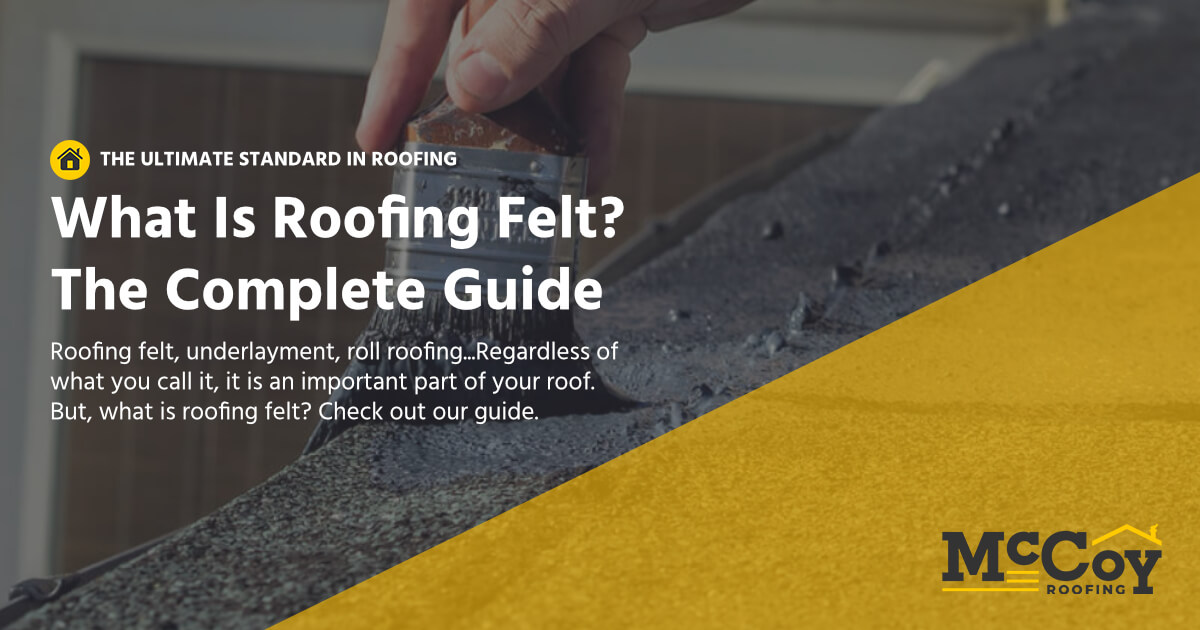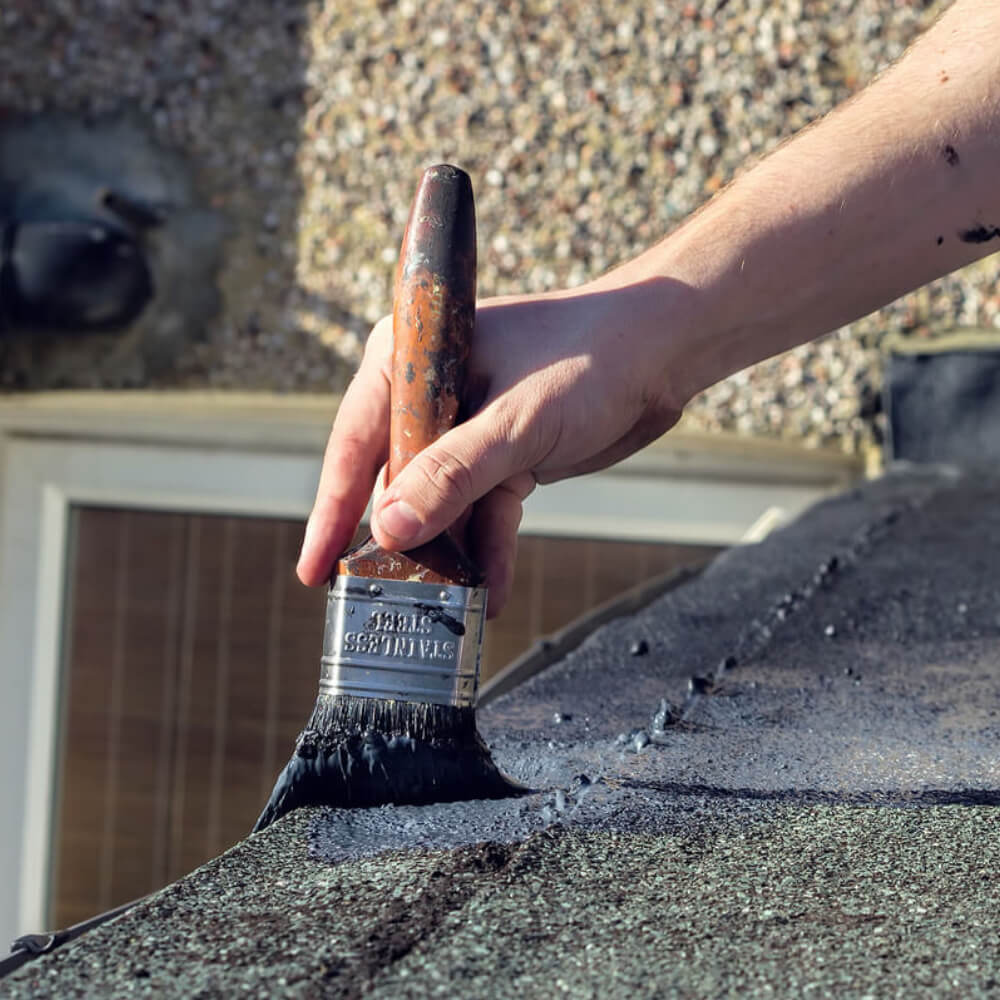

What Is Roofing Felt? The Complete Guide
Roofing felt, underlayment, roll roofing…Regardless of what you call it, it is an important part of your roof. But, what is roofing felt? Check out our guide.

Each component of your roof has an important job – and felt underlayment is no exception.
For more than two and a half decades, professional roofing organizations have recommended that contractors use felt during roof construction. The material provides waterproofing, and some municipalities require it by law.
Roofing felt is an extra layer of shielding that protects your roof and the structure of your home. Keep reading to find out more about the vital role of roof felt.
What Is Roofing Felt?
You may have heard roofing felt referred to by many names. For instance, contractors sometimes call it felt underlayment, roll roofing, or roofing tar paper. They install this protective material between shingles and roof decks.
It’s important not to confuse roof felt with felt roof shingles. The material is similar, but without the asphalt covering.
Manufacturers typically make standard roof felt with a natural base material such as wood cellulose. More recently, however, synthetic roof underlayment has grown in popularity.
Manufacturers make synthetic roofing paper with material such as fiberglass or polyester. They may also coat it with asphalt. Synthetic roofing paper is a breathable, protective coating that does a remarkable job of repelling moisture.
Over the years, roofing contractors have recognized the value of an extra layer of protection between shingles and roof decks. Also, underlayment results in a better-looking finished product that lasts longer.
Because roof felt underlayment shores up your roof, it also helps protect the underlying framework of your home from the damaging elements.
In the unfortunate event that moisture gets under your shingles, roofing felt prevents it from getting to your roof deck. It also protects water from getting trapped under your shingles. In turn, the material prevents leaks, rotting, mold and moisture damage.
How to Install Roofing Felt
Usually, manufacturers produce roofing felt in 36-inch rolls. Contractors roll the material over a roof deck in overlapping strips.
If you’re installing roofing felt, you should start at the bottom and then work your way up. If water gets past the shingles, this pattern will make it easy for it to roll down the roof. The moisture will then escape the roof shingles at the next opening and continue to the rain gutter.
Roofing felt installation is relatively straightforward. However, you should exercise caution when installing the material.
It’s important that you cover the roof completely. Wrinkles, gaps, or an incorrect overlay will compromise the material’s ability to protect the roof deck.
To secure standard roofing felt, you’ll need a hammer tacker. The tool makes it easy to staple roofing felt in place. It’s the fastest way to install the material.
With this tool, you’d use the same swing as you would with a hammer. With each impact, it will staple the paper to the deck. A tacking hammer greatly reduces the time needed to install roof felt underlay compared to using a staple gun.
If you aren’t comfortable or knowledgeable when it comes to roofing installation, you should contact a trusted professional. McCoy Roofing will always answer your questions with honesty and complete your projects with integrity and professionalism.
Synthetic Felt: A Step-Up From the Norm
For decades, contractors have used roofing felt that’s composed of heavy-duty wood cellulose. Now, however, synthetic roofing underlayment is quickly gaining popularity. Eventually, it may become an industry standard.
Contractors are making the switch for several reasons. Mainly, it’s lighter, stronger, and safer to walk on.
Synthetic roofing underlayment is a polyester or fiberglass material soaked in a waterproofing agent. Manufacturers typically make the roofing material available in two thicknesses. It comes in 15- or 30-pound weight.
When manufacturers established this standard, these weights correlated with the weight of 100 square feet of material. Now, however, the rolls are somewhat lighter. Nevertheless, the standard remains. As with traditional felt, a heavier weight provides better performance.
Synthetic felt can offer benefits beyond better weather proofing. For example, most manufacturers make traditional roofing felt using black pigment. Synthetic felt may come in a range of light colors which collect less heat. Accordingly, synthetic felt results in a cooler roof and lowered energy consumption.
Synthetic felt also performs better in the cold. In the winter, traditional felt tends to curl. Cold temperatures don’t have this effect on synthetic material.
There is one area, however, where traditional felt has an advantage. You can’t use a lightweight hammer tacker to install synthetic felt. You must use roofing nails. Still, you can overcome this issue easily with the right roofing nail gun.
Make Your Roofs Last Longer With Synthetic Felt
It’s important to choose a roofer that knows how to work with synthetic underlayment. Synthetic felt has a lower permeability (perm) rating compared to standard roof felt.
Resultantly, moisture cannot escape as easily through the material. For this reason, it’s important to hire a contractor that knows how to vent a roof properly when using synthetic felt.
Also, all synthetic underlayment may not work with all kinds of shingles. A contractor must know how to match various synthetic felt to roof coverings.
McCoy Roofing has the experience and expertise to get the job done right.
Trust Us to Protect Your Home
McCoy Roofing is an experienced residential and commercial service. We’ve performed quality roofing installations for businesses and homeowners for more than a decade.
Our contractors are experts in installing synthetic roof underlayment. We also manufacture proprietary synthetic roofing felt.
Whether you need a full roof replacement or a small repair, we’ve got you covered. Contact a friendly McCoy Roofing expert at 402-616-7304 for a free estimate. We’ve worked hard to build a reputation as an excellent roofing company and look forward to adding you to our list of satisfied clients.